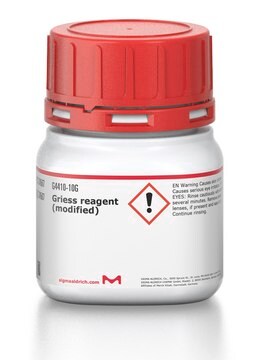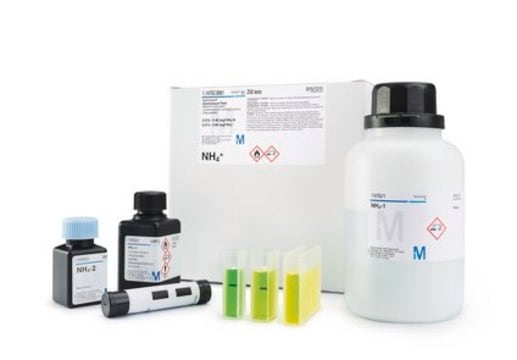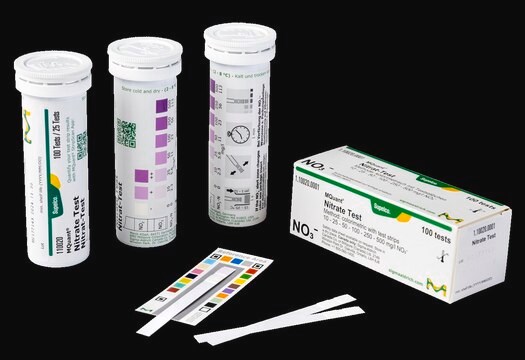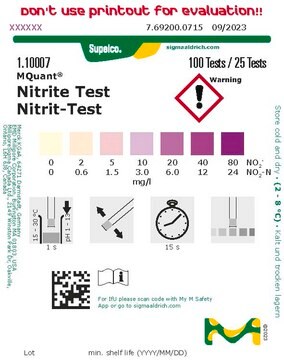23479
Nitrite/Nitrate Assay Kit, colorimetric
used for detection of nitric oxide metabolites
Synonym(s):
Nitrate/Nitrite Assay Kit, colorimetric
Sign Into View Organizational & Contract Pricing
All Photos(1)
About This Item
UNSPSC Code:
12161503
NACRES:
NA.84
Recommended Products
usage
sufficient for 100 assays
suitability
passes test for application
storage temp.
2-8°C
Related Categories
Application
Nitric oxide (NO), a gaseous paramagnetic radical, is a very important and versatile messenger in biological systems. NO is synthesized from L-arginine by NO synthase (NOS). It has been identified as an endothelial derived relaxation factor (EDRF) and antiplatelet substance. It serves as a neurotransmitter derived from a neutrophile and a cytotoxic substance from an activated macrophage. Although NO′s molecular action in the biological system is very versatile, the most important role of NO is the activation of guanylate cyclase.
The Griess assay is one of the most popular and simplest methods used to detect the NO concentration. The Griess assay′s mechanism is summarized as the azo coupling between diazonium species, which are produced from sulfanilamide with NO2, and naphthylethylenediamine. The NO2/NO3 Assay Kit contains these dyes, a nitrate reductase, an enzyme co-factor, buffer solution and NO2, NO3 solutions as standards. Therefore, total NO metabolites are easily detectable using this kit. The suitable NO2 detection range is from 10 to 100 μM.
The Griess assay is one of the most popular and simplest methods used to detect the NO concentration. The Griess assay′s mechanism is summarized as the azo coupling between diazonium species, which are produced from sulfanilamide with NO2, and naphthylethylenediamine. The NO2/NO3 Assay Kit contains these dyes, a nitrate reductase, an enzyme co-factor, buffer solution and NO2, NO3 solutions as standards. Therefore, total NO metabolites are easily detectable using this kit. The suitable NO2 detection range is from 10 to 100 μM.
Kit Components Only
Product No.
Description
- NaNO2 Standard Solution (100 mM) 1 bottle
- NaNO3 Standard Solution (100 mM) 1 bottle
- Buffer solution (20 mM, pH 7.6) 1 bottle
- Nitrate reductase (lyophilized) 1 bottle
- Enzyme Co-factor (lyophilized) 1 bottle
- Griess Reagent A 1 bottle
- Griess Reagent B 1 bottle
related product
Product No.
Description
Pricing
Signal Word
Warning
Hazard Statements
Precautionary Statements
Hazard Classifications
Eye Irrit. 2 - Met. Corr. 1 - Skin Irrit. 2 - Skin Sens. 1 - STOT SE 3
Target Organs
Respiratory system
Storage Class Code
8A - Combustible corrosive hazardous materials
Flash Point(F)
Not applicable
Flash Point(C)
Not applicable
Certificates of Analysis (COA)
Search for Certificates of Analysis (COA) by entering the products Lot/Batch Number. Lot and Batch Numbers can be found on a product’s label following the words ‘Lot’ or ‘Batch’.
Already Own This Product?
Find documentation for the products that you have recently purchased in the Document Library.
Customers Also Viewed
Mohamed Raâfet Ben Khedher et al.
Lipids in health and disease, 16(1), 241-241 (2017-12-14)
Vasculogenic erectile dysfunction (VED) is considered as a common complication among people with type 2 diabetes (T2D). We tested whether changes in fatty acid (FAs) classes measured in erythrocytes are associated with increased risk of diabetic VED along with related
Fredrik Sjövall et al.
PloS one, 9(5), e97673-e97673 (2014-05-16)
The levels of nitric oxide (NO) and various cytokines are known to be increased during sepsis. These signaling molecules could potentially act as regulators and underlie the enhancement of mitochondrial function described in the later phase of sepsis. Therefore, we
Wang Kuan-Hong et al.
Archives of medical science : AMS, 14(5), 1112-1118 (2018-08-30)
Redox signaling initiates pathogenesis of neuronal degeneration. Plumbagin is a potential antioxidant with anti-inflammatory, anti-cancer and radio sensitizing properties. In the present study, we aimed to determine the protective role of plumbagin against H2O2-induced neurotoxicity in PC12 cells by determining
Iselin Vildmyren et al.
Nutrients, 10(12) (2018-11-25)
Hypertension is the leading risk factor for cardiovascular disease, and prevention of high blood pressure through diet and lifestyle should be a preferred approach. High intake of fish is associated with lower blood pressure, possibly mediated through the proteins since
Gerlane F De Brito et al.
Meat science, 130, 81-90 (2017-04-26)
The aim of this study was to evaluate the effect of different forage-types on lamb meat quality parameters. White Dorper lambs that had grazed five forage-types, were slaughtered commercially. At 24h post-mortem, the m. longissimus lumborum (LL) was removed from
Our team of scientists has experience in all areas of research including Life Science, Material Science, Chemical Synthesis, Chromatography, Analytical and many others.
Contact Technical Service





![Nitrate Reductase (NAD[P]H) from Aspergillus niger lyophilized powder, ≥300 units/g solid](/deepweb/assets/sigmaaldrich/product/images/309/282/2a67ae4d-ca55-4f0b-96ec-34748ff8a21e/640/2a67ae4d-ca55-4f0b-96ec-34748ff8a21e.jpg)
![Nitrate Reductase (NAD[P]H) From Pichia Pastoris, recombinant freeze-dried protein glass](/deepweb/assets/sigmaaldrich/product/images/859/572/ae8d80df-c6d0-4cce-a526-35f8e21ca729/640/ae8d80df-c6d0-4cce-a526-35f8e21ca729.jpg)



